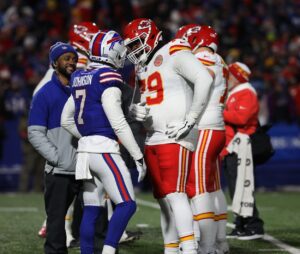The surface storyline paints one picture of a team; a picture convoluted with distractions and quick-takes. However, there is always a story underneath the overarching story which tells a longer, more detailed story to pick apart and use for projections. Follow the underlying story, and the truth of a situation plays out. And in week 14, the underlying story of the Kansas City Chiefs beating the Oakland Raiders painted a complete picture of the demands put on them for tenured success.
The 26-15 victory provided hope, but also boxed the Chiefs into a direct need to win. Kareem Hunt rushed for 116 yards, Tyreek Hill continued dashing defenses, and the defense sacked Derek Carr three times. Cast aside anomalies of random success – the Chiefs succeed on the model of powerful running and philosophically shutting down the pass before it launches. However, sustained winning out of that box is difficult. The Kansas City Chiefs week 14 stats completed a picture of what it takes for the offense to carry a comfortable lead and a defense to serve a proper dressing for success.
Kansas City Chiefs Week 14 Stats and Charts – Boring Still Wins
Chaos Theory
(At this point in the season, it might be a good time to revisit the concept of chaos theory. In week one, the mathematical debauchery was explained as essentially a fractal graph that assigned value to outcomes in a game, defining which team had more momentum or chaos control.)
The Kansas City Chiefs started the game off strong behind the Arrowhead Stadium crowd. Again, when a team desperately trying to hold onto their season, a la the Raiders, enter Arrowhead Stadium, they often leave even more depressed. Whether it be the twisting home field advantage, or the nightmares of games past, playing in Kansas City continues to be Jack Del Rio’s death knell.
The game started out as such when Chris Jones initiated chaos by sacking Carr. Immediately, the number one goal for the Chiefs defense was accomplished, setting the tone for exactly what the Chiefs intended to do. Just as past matchups have been paved by an early, physical precedent, Sunday provided that sharp projection once again.
The Chiefs could have taken further advantage of the chaos by racing to a touchdown. The game does not end in the first quarter, as made evident against the New York Jets, but the trajectory would have provided essential support to an embattled defense.
Naturally, however, the more things change, the more they stay the same. After Alex Smith was sacked by Bruce Irvin, the Kansas City field goals said hello with Harrison Butker nailing a 53-yard field goal to give an early 3-0 lead.
The Raiders offense that was so wildly brazen in week seven came out and looked the better part of a coy possum in the first half. Anything that was momentum was just a display of sharp teeth and no bite. Four of the five Raiders drives ended in punts, while one more ended in an interception.
The interception, mathematically speaking, came at an opportune time. The score was merely 13-0 at that point, and the Raiders were on the precipice of stringing together a key touchdown drive seven plays in. Terrance Mitchell stepped in front of the pass and made, under the notion of chaos, the most important play of the game. Mitchell spread frustration and killed a prime opportunity for the Raiders to take away the opportunity the defense provided.
At halftime, with a score of 16-0, the Chiefs offense, not the defense, left opportunity on the field. Field goals are precious for the Chiefs to take advantage of, and what has historically made them successful in the Andy Reid era is gaining points even when the touchdowns do not come. Hence, the nickname the “Kansas City Field Goals.”
However, to beat teams on an upward trajectory (looking at the Los Angeles Chargers) the Kansas City Field Goals will have to take the back-burner to more precarious, touchdown drives. The second half defense continues to make that an evil necessity.
The Chiefs came out in the second half marching to the same tune as the first – more field goals on offense, more forced punts on defense. In an old-fashioned manner, the Chiefs defense played aggressively astute defense, and even garnered a fumble halfway through the third that put them in a 75-percentile bracket to win.
Preventing the Raiders from getting a hint early was essential. As tradition typically goes, the fourth quarter is Christmas time for opposing offenses. With 11 minutes left, Carr marched the Raiders down the field in a two-minute offense and scored a touchdown. A gut-punch onside kick gave the Raiders the ball and another touchdown drive as the Chiefs started inflicting penalties upon themselves.
A third touchdown drive was in order for the Raiders, but ultimately too little too late as Steven Terrell intercepted the ball in the end zone. The comeback would have been miraculous, but not completely out of a crazy NFL picture.
Lesson learned from the chaos model on the season: The Chiefs defense cannot be trusted to keep any lead heading into the fourth quarter.
Running to Glory
The Chiefs offense came out in 2017 and blew the NFL, analysts, and the Chiefs themselves away by featuring Smith as a deep passing phenomenon. In earlier iterations of data, however, that was dismissed as a mere perception of a more wisely timed Reid offense; the trick was Smith was not forcing passes. As the season trickled on, the perception became a forced aspect of the passing game and evidently gave way to the Chiefs dripping their way to losses and then egregious interceptions.
As fascinating as the Smith-explosive offense was, the experiment ought to die. If the Chiefs want to beat the Chargers or have any hope of success over the next three games, they must run the ball to control the clock, and support the defense. Furthermore, the Chiefs offense needs to drop the endless field goal moniker in exchange for one more touchdown per game. Scoring 26 points is good enough to beat most teams; to come back and beat a high-flying offense, the Chiefs would be better off safely chugging their way to 30 or more.
The data provided needs to build a sustainable, not flashy offense. From his time coaching the Philadelphia Eagles to his tenure with the Chiefs, Reid operates best in a boring, west-coast offensive set with an emphasis on pesky third-down success. A boring win is a win.
To provide a model of the importance of not only kicking field goals, consider that Butker averages 10.4 points per game, good enough for 11th in the NFL among kickers. He’s also tied for the eighth most field goal attempts with 30. (Greg Zuerlein leads the league for the Los Angeles Rams with 38 field goal attempts).
Now while that seems like a fully functional statistic not too egregious, weigh in the touchdown to field goal ratio. For every offensive touchdown scored, the Chiefs have kicked a field goal (31:31). While that margin does not seem atrocious, consider no team has won the Super Bowl in the past decade by equaling their touchdowns to field goals.
The metric is emblematic of a team over-reliant on finishing drives off with three points opposed to seven, or more bluntly, stalling. Do that once or twice in a game, eight possible points are ripped from the board.
Further established in Sunday’s game was Hunt, Charcandrick West, and the run game. The Chiefs as a team ran for 165 yards on 33 attempts, good enough for the team’s fourth best performance, and Hunt’s third best performance. Furthermore, they were able to puncture the Raiders at every single gap.
Noticeably weak was the Raiders interior, which Hunt poked 21 times for 78 yards. West tacked on another four attempts in the interior lanes for 25 yards. The facet about the interior runs that are so important involves the concept of a grinding, counter run game which demoralizes team’s mentally, and physically sets a presence.
West did have two drops, but his four runs came in important moments, including a touchdown run on a second and nine in the third. His functional versatility builds in another threat, that while not explosive or fancy, still possesses a viable target who can be trusted.
The pass game was more erratic, but still functional. Smith targeted the deep zones of the field nine times, completing three. Granted, one reception relied on Albert Wilson making a phenomenal catch down the sideline.
Building in context to these passes, six of the nine came during the first half. Hence, they were built on former plays and the run so Smith didn’t have to force passes in double-coverage. The offense went much more conservative in the second half and was allowed to focus on the run to remain consistent.
Again, everything points back to the points the Chiefs being conservative and boring remaining the way safely win. As seen in years past, it puts a major onus on the defense, which builds problems substantive success.
To conclude with an emphasis on the running game metric, since 2013, the Chiefs are 16-4 when rushing over 150 yards, 28-11 when rushing for 120 yards or more, and 41-10 when rushing for more than 25 attempts.
Under Pressure
Earlier in the season, the Raiders and Chiefs played to a very different tune. Although the Chiefs played decent offense against the Raiders the first time around, the defense imploded and allowed Carr to pass over 50 times. Carr was kept to only 41 attempts this time around, with the main difference coming from insistent pressure with three sacks.
And those three sacks could not have been more important. Not only did they set the tone for the physical matchup, but they provided Carr’s quick reads which resulted in two interceptions.
No doubt, Amari Cooper’s mere 15 plays helped the Chiefs secondary out with one less target for Carr to work with. Furthermore, the Chiefs effectively assisted Cordarrelle Patterson to shut himself down. On six targets, he had only three receptions for eight yards, with seven yards coming on one reception.
The emphasis on Patterson builds a notion across the game in which Carr insistently checked down and patterned his targets quickly. Michael Crabtree saw 11 targets in the short range, while only being targeted deep twice. As a whole, Carr threw 10 passes deep, and connected on one.
Connecting the Chiefs defensive scheme to the short targets, when operating in more of a zone coverage involved with aggressive corners, the key is to keep everything in front. Hence, Mitchell and Darrelle Revis saw much of their time not running in circles, but keeping routes in front of them based on physical technique. Revis’ age is especially assisted by the lack of deep passes.
However, what allows the system to work is the pass rush. The previous weeks in the season saw a front seven wholly bereft of purpose. This week, Carr was sacked three times, with Jarvis Jenkins, Chris Jones, and Justin Houston all coming up big. Insistent pressure from the interior removes the threat of sustained passing routes which take three or more seconds to evolve. Thus, the corners can keep everything in front of them, limiting the potential to break.
The Chiefs may not have the best secondary in the NFL, but the pass rush is exactly what propels the team to success. Since 2013, with one or more sack, they are 44-23; two or more sacks, they are 38-10.
Intermix in an early lead, forcing the run game to only attempt 11 carries, and the Chiefs paved their way to a safe victory on Sunday.
Main Image:






